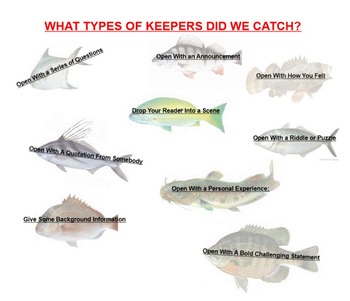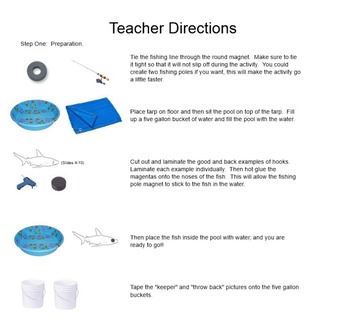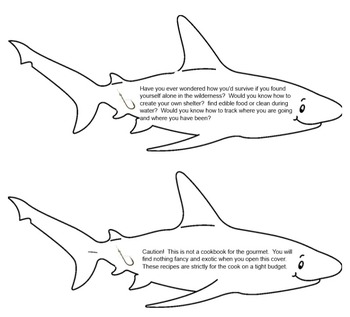Writing Hooks - Fishing For A Hook Activity (Smart Notebook Version)
MyPaths
1.9k Followers
Grade Levels
4th - 9th
Subjects
Resource Type
Formats Included
- NOTEBOOK (SMARTboard) File
Pages
20 pages
MyPaths
1.9k Followers
Description
Students have a hard time understanding hooks, and the importance of a good "hook". This engaging lesson will have students literally "fishing for hooks". They will discover the importance of hooks in their persuasive writing. After students learn what a hook is, they will actually fish for hooks in a plastic swimming pool using a fishing pole and magnet. Once they fish out a "hook" they will read the hook and determine its effectiveness. This activity provides an engaging way to teach students what a hook is, why they are important to use in their writing, provides them with variety of examples to analyze and use as mentor texts, and gives them a chance to practice and share hooks of their own.
GOAL: Students will understand what a hook is, why they are important to use in their writing, analyze a variety of examples for effectiveness, and use those mentor hooks as a model to practice and create their own.
MATERIALS: A little fishing pole with a magnet on the end of it (not provided)
Magnets to glue onto different hook examples (not provided)
Hot glue gun (not provided)
A kids plastic swimming pool (not provided)
Cut up copies of different types of hooks (provided)
Cut up examples of poor hooks (provided)
Water
Tarp/Towels for floor
Handouts (provided)
COMMON CORE STANDARDS:
RI.6.1 Cite textual evidence to support analysis of what the text says explicitly as well as inferences drawn from the text.
RI.6.3 Analyze in detail how a key individual, event, or idea is introduced, illustrated, and elaborated in a text (e.g., through examples or anecdotes).
RI.6.5 Analyze how a particular sentence, paragraph, chapter, or section fits into the overall structure of a text and contributes to the development of the ideas.
W.6.1a Introduce claim(s) and organize the reasons and evidence clearly.
W.6.4 Produce clear and coherent writing in which the development, organization, and style are appropriate to task, purpose, and audience. (Grade-specific expectations for writing types are defined in standards 1–3 above.)
SL.6.1 Engage effectively in a range of collaborative discussions (one-on-one, in groups, and teacher-led) with diverse partners on grade 6 topics, texts, and issues, building on others’ ideas and expressing their own clearly.
Step 2: Start off by asking students if they know what a hook is? Some students may know, and some students may not know. Have students write down what they feel a hook is on sticky notes and hang the sticky notes up on a piece of chart paper. Call upon a students to share what they feel a hook is. Leave the sticky notes on the chart paper so that the students can revise there answers throughout the discussion. Then, have students look at slide 5 and ask them to read the top sentence. Ask them their opinions about if that sounds like a paper they want to read, or if it sounds boring.
Move the red box, and have students read the hook with the topic sentence. Allow students to compare the two paragraphs and see if they can come up with/confirm their understanding of what a hook is from earlier. Once again look at the chart paper, and read of each sticky notes. Ask students if the description should stay "be a keeper" or should get thrown back in the water. Read the sticky notes that are left, and have students work together in a pair, and try to synthesize what they learned and the sticky notes to come up with a good definition of what a hook is. Allow students time to share those definitions. To really challenge students, they could create a metaphor of what a hook is and why they are important. For example, a hook is like the supercharged engine of a car, it makes your paper interesting and people want to see it. You can use slides 6 and 7 to help record student thoughts.
Step 3: Using slide 8, you can go over what a hook is, and why they are important to reinforce the classroom definition. Have students write their definitions, metaphors, and this definition in their journal to help them keep track of their notes.
Step 4: Tell students now that they know what a hook is and understand why they are important, they will have a chance to discover different types of hooks. Pull out the fishing pole and tell them that they are about to fish for different types of hooks. The rules are that when they catch a fish, they will read the hook and determine if the fish is a keeper or not. This will allow students to analyze the text and really think about if the writer is being effective or not. Be sure to tell students to cast gently, and towards the pool. You do not want any accidents to happen =-). Once they catch a fish, and after they read the sentence(s) on the fish, the class will determine if the hook is effective or not by calling the fish a "keeper" or a "throw back". Use slide 9 and 10 to print off the keeper/throwback pictures and tape them on the five gallon buckets. This will allow students to separate out what hooks they feel are effective and which ones they feel are not.
Step 5: After students have gone through and determined if the hook was a "keeper" or "throw back" it is time to determine what type of fish they caught. Now that your keepers are in the bucket, pull out the bucket and pass one out to random students. Have a roll of masking tape, with you. Turn to slide 19 and have students see if they can infer/identify the type of hooks that they caught. After each student reads the hook they have, the class can debate what kind of example that hook is. Have students bring you the fish and put some masking tape on the back, and stick it where they feel it belongs. Then, pass out the hook mentor text (slide 18) and have students look at the different hooks that they just caught. They can check to see what they identified correctly.
Step 6: Now, using the list of persuasive writing prompts provided, or having students revise an earlier writing piece, or coming up with your own authentic prompts, have students pick two or three different types of hooks and test them out. Allow them time to share their hooks as a group, and then share them out loud. Have them write the one hook that they are most proud of on the "Great Catch" (slide 20) sheet. These can be hung up in the classroom to display students' thinking. In their journals, have students write about what they learned today, that will make them betters writers later. Have them hand in their journals to use as a formative assessment, and see where the students are for the next day.
GOAL: Students will understand what a hook is, why they are important to use in their writing, analyze a variety of examples for effectiveness, and use those mentor hooks as a model to practice and create their own.
MATERIALS: A little fishing pole with a magnet on the end of it (not provided)
Magnets to glue onto different hook examples (not provided)
Hot glue gun (not provided)
A kids plastic swimming pool (not provided)
Cut up copies of different types of hooks (provided)
Cut up examples of poor hooks (provided)
Water
Tarp/Towels for floor
Handouts (provided)
COMMON CORE STANDARDS:
RI.6.1 Cite textual evidence to support analysis of what the text says explicitly as well as inferences drawn from the text.
RI.6.3 Analyze in detail how a key individual, event, or idea is introduced, illustrated, and elaborated in a text (e.g., through examples or anecdotes).
RI.6.5 Analyze how a particular sentence, paragraph, chapter, or section fits into the overall structure of a text and contributes to the development of the ideas.
W.6.1a Introduce claim(s) and organize the reasons and evidence clearly.
W.6.4 Produce clear and coherent writing in which the development, organization, and style are appropriate to task, purpose, and audience. (Grade-specific expectations for writing types are defined in standards 1–3 above.)
SL.6.1 Engage effectively in a range of collaborative discussions (one-on-one, in groups, and teacher-led) with diverse partners on grade 6 topics, texts, and issues, building on others’ ideas and expressing their own clearly.
Step 2: Start off by asking students if they know what a hook is? Some students may know, and some students may not know. Have students write down what they feel a hook is on sticky notes and hang the sticky notes up on a piece of chart paper. Call upon a students to share what they feel a hook is. Leave the sticky notes on the chart paper so that the students can revise there answers throughout the discussion. Then, have students look at slide 5 and ask them to read the top sentence. Ask them their opinions about if that sounds like a paper they want to read, or if it sounds boring.
Move the red box, and have students read the hook with the topic sentence. Allow students to compare the two paragraphs and see if they can come up with/confirm their understanding of what a hook is from earlier. Once again look at the chart paper, and read of each sticky notes. Ask students if the description should stay "be a keeper" or should get thrown back in the water. Read the sticky notes that are left, and have students work together in a pair, and try to synthesize what they learned and the sticky notes to come up with a good definition of what a hook is. Allow students time to share those definitions. To really challenge students, they could create a metaphor of what a hook is and why they are important. For example, a hook is like the supercharged engine of a car, it makes your paper interesting and people want to see it. You can use slides 6 and 7 to help record student thoughts.
Step 3: Using slide 8, you can go over what a hook is, and why they are important to reinforce the classroom definition. Have students write their definitions, metaphors, and this definition in their journal to help them keep track of their notes.
Step 4: Tell students now that they know what a hook is and understand why they are important, they will have a chance to discover different types of hooks. Pull out the fishing pole and tell them that they are about to fish for different types of hooks. The rules are that when they catch a fish, they will read the hook and determine if the fish is a keeper or not. This will allow students to analyze the text and really think about if the writer is being effective or not. Be sure to tell students to cast gently, and towards the pool. You do not want any accidents to happen =-). Once they catch a fish, and after they read the sentence(s) on the fish, the class will determine if the hook is effective or not by calling the fish a "keeper" or a "throw back". Use slide 9 and 10 to print off the keeper/throwback pictures and tape them on the five gallon buckets. This will allow students to separate out what hooks they feel are effective and which ones they feel are not.
Step 5: After students have gone through and determined if the hook was a "keeper" or "throw back" it is time to determine what type of fish they caught. Now that your keepers are in the bucket, pull out the bucket and pass one out to random students. Have a roll of masking tape, with you. Turn to slide 19 and have students see if they can infer/identify the type of hooks that they caught. After each student reads the hook they have, the class can debate what kind of example that hook is. Have students bring you the fish and put some masking tape on the back, and stick it where they feel it belongs. Then, pass out the hook mentor text (slide 18) and have students look at the different hooks that they just caught. They can check to see what they identified correctly.
Step 6: Now, using the list of persuasive writing prompts provided, or having students revise an earlier writing piece, or coming up with your own authentic prompts, have students pick two or three different types of hooks and test them out. Allow them time to share their hooks as a group, and then share them out loud. Have them write the one hook that they are most proud of on the "Great Catch" (slide 20) sheet. These can be hung up in the classroom to display students' thinking. In their journals, have students write about what they learned today, that will make them betters writers later. Have them hand in their journals to use as a formative assessment, and see where the students are for the next day.
Total Pages
20 pages
Answer Key
Does not apply
Teaching Duration
90 minutes
Report this resource to TPT
Reported resources will be reviewed by our team. Report this resource to let us know if this resource violates TPT’s content guidelines.





